It’s Spring!
Posted in Programs and Events on March 20 2009, by Plant Talk
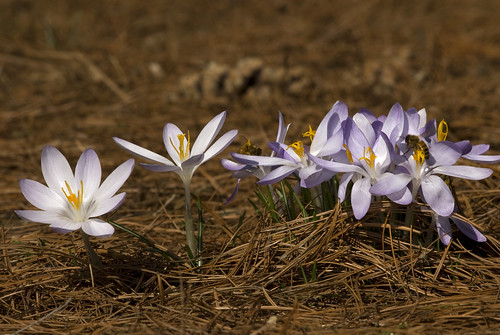
Check out all of Saturday’s programming.
Check out all of Sunday’s programming.

Inside The New York Botanical Garden
Posted in Programs and Events on March 20 2009, by Plant Talk

Check out all of Saturday’s programming.
Check out all of Sunday’s programming.
Posted in Exhibitions, Moore in America, Programs and Events on March 13 2009, by Plant Talk
This weekend marks the end of the nearly 10-month run of Moore in America, the largest outdoor exhibition of the famed sculptor’s work in a single venue in the United States. Visitors to the Botanical Garden were able to view his magnificent work across this historic landscape in four seasons (as seen here); the show opened May 24, 2008.
Art in Nature walking tours of the show will be held both Saturday and Sunday so you can get one more look at these monumental pieces in this wonderful setting.
Check out all of Saturday’s programming.
Check out all of Sunday’s programming.
Posted in Learning Experiences, Programs and Events on March 12 2009, by Plant Talk
 Carol Capobianco is Editorial Content Manager at The New York Botanical Garden.
Carol Capobianco is Editorial Content Manager at The New York Botanical Garden.
I recently completed a New York Botanical Garden Continuing Education course, Soil Science for Gardeners, with instructor David Bulpitt.
While that’s not remarkable in itself, it’s noteworthy because I had first become acquainted with David Bulpitt and his passion for soils at a Continuing Education Open House and promised myself that one day I would take his course. That was nine years ago!
It was the spring of 2000 when I attended the Open House to learn about taking classes so that I could finally gain some theory for the seat-of-the-pants home gardening I’d been doing and to investigate the various certificate programs offered at The New York Botanical Garden—the definitive source of everything related to plants.
At the free Open Houses, which are held twice a year, on a single day you can wander in and out of ongoing mini-classes on subjects related to seven main disciplines, some of which can lead to a career change such as Landscape Design or Horticultural Therapy, as well as hear about the School of Professional Horticulture. The setting is informal, you meet some of the instructors and program coordinators, and you feel a kindred spiritedness with the other searching, prospective students.
That day I was determined to at least poke my head into each of the rooms hosting the different topics so I could sample all the possibilities. I hesitated, however, when I came to the Horticulture presentation titled “Soil Science.” Oooh. That sounded boring. But, the curious sort that I am, I took a deep breath and walked in. Arrayed on tables were several samples of soils and testing paraphernalia. David, who led the session, was talking animatedly about soil texture and structure and permeability. I sat there fascinated. It was an hour later when I finally dislodged myself, knowing that I wanted to make my way to other classrooms and subjects.
After that Open House I registered for several classes, mostly in gardening and botany, all of which I completed with high marks. At the time, David Bulpitt was teaching Soil Science only as a two-course offering in the Horticulture program, which was too intensive for my needs. And so, I put the encounter in my memory bank. However, when I perused the Continuing Education Fall 2008–Winter 2009 Catalog and realized that he now teaches a more condensed, less-extensive class for the Gardening discipline as well, I immediately registered for the course.
Four weeks and lots of weighty information later, I’m feeling a great sense of fulfillment, and I’m armed with important new knowledge to take into my home garden this spring. The experience has renewed my excitement to learn, and I’ve begun skimming the newly released Spring–Summer Catalog and even the online version to find new courses to take. I invite you to attend this weekend’s Open House and begin your own journey.
Posted in Exhibitions, Programs and Events, The Orchid Show on March 5 2009, by Plant Talk
 |
Amanda Gordon writes about the New York City social scene. |
The New York Botanical Garden is not only skilled at cultivating orchids, it also knows how to keep its annual Orchid Dinner fundraiser blooming.
“In this difficult time, we’ve raised almost $600,000,” announced gala chair and Botanical Garden board member Mary Davidson at the February 24 event at the Rainbow Room in Manhattan.
The steadiness of support is owed to the loyalty the Botanical Garden inspires. “The finest in the USA, The New York Botanical Garden deserves support in the best of times and the worst of times and at all times,” Fernanda Kellogg, president of The Tiffany & Co. Foundation, said. Orchids are of particular interest to the Foundation because in 1900 Tiffany & Co. won its first international award at the World Exposition in Paris with a collection of jeweled orchids.
Guests also enjoy buying tickets to this event because it offers such a beautiful spectacle of orchids, as featured in 28 centerpieces—one for each dinner table—created by top designers at the invitation of Veranda magazine editor-at-large and design maven Carolyn Englefield.
“My favorite part of the evening is walking into the dining room for the first time and seeing the incredibly creative centerpieces. They are amazing!” said gala chair Gillian Miniter, who in keeping with the theme wore an Angel Sanchez gold cocktail dress with flowers on the torso.
Gala chair Deborah Royce formally thanked the designers at the podium for their extraordinary effort. Among their feats: Alan Tanksley designed a cornucopia of purple orchids in a handcrafted black-and-white vase. Elise Cullman and Lee Cavanaugh wrapped orange orchids around a gold wireframe. Barclay Butera used white orchids and driftwood to transport guests to a beach setting, complete with sand dollars at each place setting. Darren Henault placed a disco-sized ball of white orchids atop a Chinese vase and made it glow by placing battery-operated lights inside.
Guests also had the opportunity to purchase orchids to take home. Many noted that the orchids were of the highest quality. In fact, they were hand-picked by The New York Botanical Garden’s Manager of the Nolen Greenhouses for Living Collections and Curator of The Orchid Show, Marc Hachadourian, who was on hand to answer questions about their care.
The dinner was a brief break from his busy schedule working on the Garden’s 7th annual Orchid Show, which opened on Saturday. A dramatic mosaic by the late Brazilian landscape architect and artist Roberto Burle Marx takes center stage in the Palms of the Americas Gallery in the landmark Enid A. Haupt Conservatory.
“It will be like nothing you’ve ever seen,” the president of the Garden, Gregory Long, told guests at the dinner, describing the design for the show by landscape architect Raymond Jungles as “architectonic.”
As for tending orchids at home, that’s another story. Fernanda Kellogg leaves the orchid care to her husband. “Kirk has the orchid green thumb,” she said. “He lived in Florida and learned to grow and nurture these quirky plants, so we always have orchid plants blooming at home. The orchids are off-limits to the housekeeper and the same goes for me!”
“I have tried to resuscitate orchids many times,” said Jane Pauley, the former Today Show co-anchor, as she walked across the dance floor in the Rainbow Room with Alan Tanksley. She got better results with less effort. “After sheer neglect, one plant gave us six more flowers,” she said.
Elise Cullman said orchid care is worth learning, especially in a recession. “Orchids are good value; they last much longer than fresh-cut flowers,” she explained. And she shared an orchid tip from a friend, author Patrizia Chen: “She sings to her orchids.”
For tips from Botanical Garden experts on caring for your orchids, check The Orchid Show blog regularly, visit the Home Gardening Online Web pages, or come to the many on-site demonstrations, Q&A sessions, and classes at the Garden.
Posted in Programs and Events, Wildlife on February 20 2009, by Plant Talk
Birders Treated to Uncommon Sightings and Start of Mating Season
 |
Debbie Becker leads a free bird walk at the Garden every Saturday from 11 a.m. to 12:30 p.m., beginning at the Reflecting Pool in the Leon Levy Visitor Center. |
 The other day I watched two male house sparrows competing for the attention of a female bird who seemed totally disinterested in their mating dance. With tail feathers extended they jumped, hopped, and vied for her attention. She seemed distracted and eventually flew away leaving the two male birds confused and looking for another female to shower with attention.
The other day I watched two male house sparrows competing for the attention of a female bird who seemed totally disinterested in their mating dance. With tail feathers extended they jumped, hopped, and vied for her attention. She seemed distracted and eventually flew away leaving the two male birds confused and looking for another female to shower with attention.
February marks the beginning of spring for many birds. It is the start of their mating season. Even though the temperature is hovering around 30 degrees and remnants of snow are on the ground, for birds love is in the air. Perhaps Valentine’s Day was created with birds in mind. What reasonable human really thinks about love during the coldest month of the year? Roses wilt, balloons deflate, and chocolate gets hard in the February frost. But for birds, their warm little bodies and courtship rituals begin to stir as tiny buds form on early blooming trees.
Bird watching has long been regarded as an act of love. For those of us who bundle up in the winter and drudge along snow-laden pathways in the Garden, it is a yearning of the heart that keeps us warm and drives us on. Our quest to see the owls, hear the mourning doves cry, watch the red-tailed hawks soar above, and feed the chickadees from our palms are all acts of unselfish and undying love. What else would motivate us to wake up early on a Saturday morning, don layers of clothes, gloves, boots, hand warmers, hats, and scarfs to brave the cold winds of February and March to go birding.
This year especially, the birding lovebug has bitten many. Because of the global changes and an unusually cold winter, many birds that normally are residents of Canada and the northeastern United States have been driven south by snow and an inability to find food. Much to the delight of birders in New York City and Long Island, white-winged crossbills, snow buntings, lapland longspur, pine siskins, snowy owls, snow geese, long-eared owls, and northern saw-whet owls, and bald eagles have been visiting our area. Earlier this month in the Garden 15 white-winged crossbills delighted a large group of birders with their chatter and acrobatic behavior as they hung from pine cones searching for food. We ran after them as they flew from tree to tree, careful not to slip on the ice but eager to see a sure life-bird for everyone on the bird tour.
Love is a universal feeling, and perhaps birders feel love a bit deeper than most. It is a love for the hobby of birding that drives us to preserve the natural habitats of our feathered friends. We may protest in the form of letters or e-mails about any habitat that is going to be torn down for a shopping center or housing development. Bird lovers will go that extra mile to keep secret an owl roost or to protect the location of a rare bird. I have witnessed passionate debates over the identification of an unrecognizable avian visitor.
Perhaps no other hobby elicits participation from a such a varied number of people. On my bird walks I have met students, politicians, lawyers, doctors, designers, secretaries, teachers, retirees, world travelers, consultants, photographers, writers, and more. The one common thread is the love of birding. And in this month of February with cupid looming about and the beginning of the spring mating season at hand, I hope to meet more people in love with the act of birding on my Saturday bird walks.
Check out all of Saturday’s programming.
Check out all of Sunday’s programming.
Posted in Programs and Events on February 13 2009, by Plant Talk
Multiple Events on Tap for Weeklong Celebration
 |
Gayle Schmidt is Manger of Public Education. |
Each year at this time the nation highlights African Americans who have had a great influence on society through innovative inventions and revolutionary ideas. This year, we are even making history while celebrating it!
During the coming week, which is a vacation week for many schools, the Garden is offering family programming to celebrate the accomplishments of African Americans in the fields of science and horticulture as well as in social affairs. The programs expose the strong will and determination of creative people to succeed beyond imposed limitations.
The Life and Work of George Washington Carver is this season’s exhibition in the Everett Children’s Adventure Garden. Dr. Carver was entirely self-motivated to get an education and to get ahead in life, which is most remarkable since he grew up in the time of slavery. In the Adventure Garden, young scientists-to-be can put on a lab coat and be a “plant doctor,” diagnosing a thirst for water or need for sunshine, and conduct simple experiments as well.
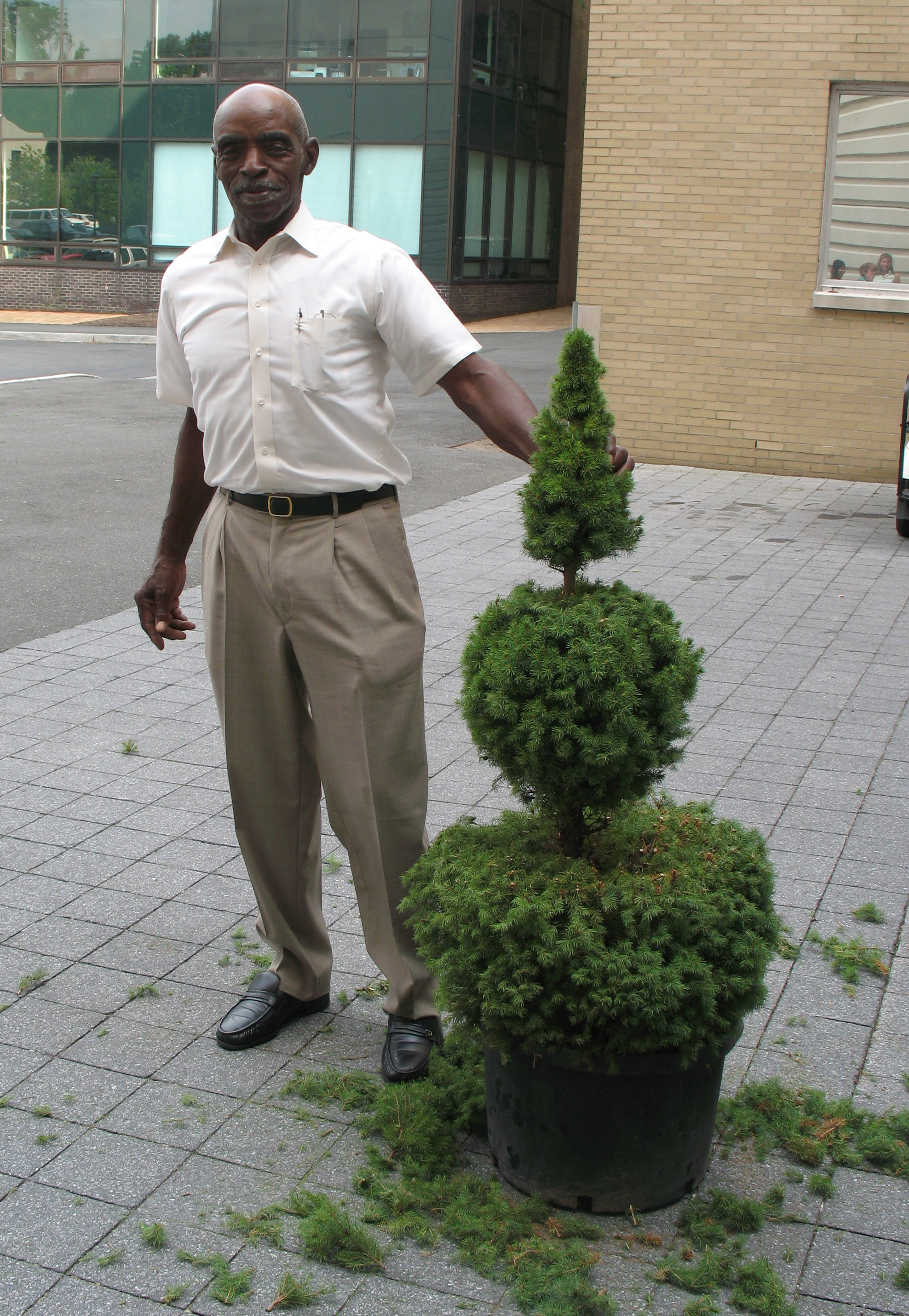 Elsewhere in the Garden, we will be showing films that tell the story of other garden lovers: the self-made topiary artist Pearl Fryer, pictured at right, and poet Anne Spencer. Fryer entered a Lawn of the Year contest and quickly got caught up in the excitement of trimming his hedges, bushes, and trees. He, too, was a “plant doctor” of sorts, often using discarded seedlings from a local nursery to add to his own collection. Fryer visited the Garden this past summer and showed off some of his pruning skills and finesse on an Alberta spruce.
Elsewhere in the Garden, we will be showing films that tell the story of other garden lovers: the self-made topiary artist Pearl Fryer, pictured at right, and poet Anne Spencer. Fryer entered a Lawn of the Year contest and quickly got caught up in the excitement of trimming his hedges, bushes, and trees. He, too, was a “plant doctor” of sorts, often using discarded seedlings from a local nursery to add to his own collection. Fryer visited the Garden this past summer and showed off some of his pruning skills and finesse on an Alberta spruce.
Spencer, who died in 1975, created a sanctuary at her home where she could reflect and write poetry that spoke to many. She hosted many renowned friends, including George Washington Carver, W.E.B. DuBois, Mary McLeod Bethune, Martin Luther King, Jr., and Thurgood Marshall, in her lush and fruitful garden. Imagine the conversations caught in the breeze!
In addition to these events, we will be hosting live musical performances. A full schedule can be found on our online calendar.
We celebrate history to learn from it and to be inspired by its role models. Come spend time at the Botanical Garden this coming week to hear the stories of those who helped shape the history of America.
Check out all of Saturday’s programming
Check out all of Sunday’s programming
Posted in Learning Experiences, Programs and Events on February 6 2009, by Plant Talk
Much to Do Here, Even at this Time of Year—Surprised?
 Carol Capobianco is Editorial Content Manager at The New York Botanical Garden.
Carol Capobianco is Editorial Content Manager at The New York Botanical Garden.
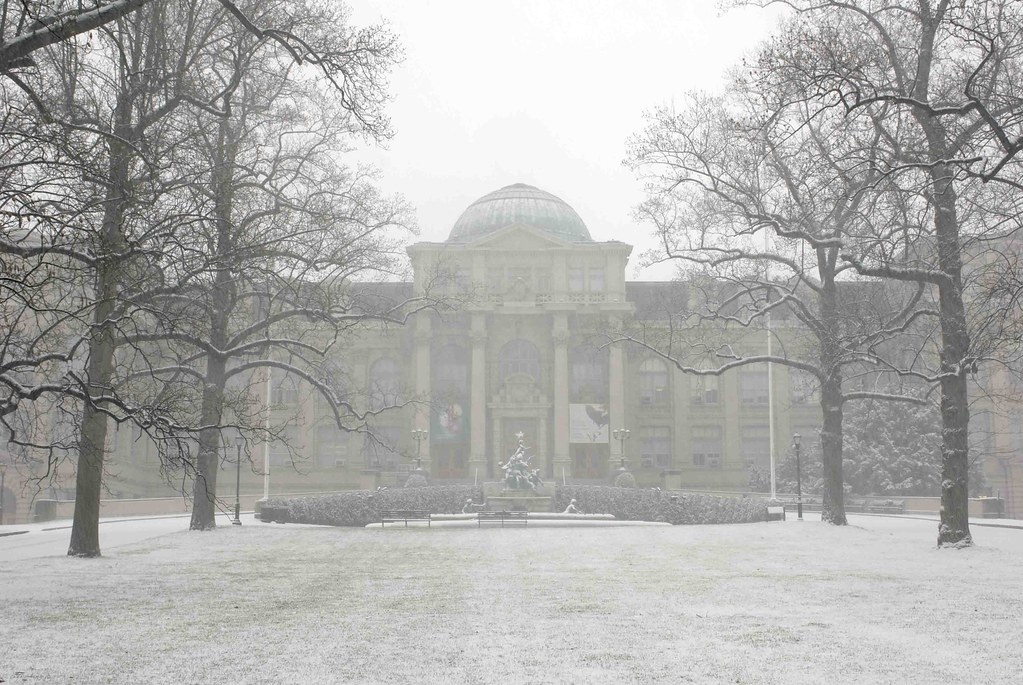 Yes, it’s below freezing outside. Yes, most plants are dormant and bedded under a blanket of snow. Yes, it’s a great time to come to The New York Botanical Garden with fresh eyes to take in the standing and specialty exhibits you haven’t yet seen.
Yes, it’s below freezing outside. Yes, most plants are dormant and bedded under a blanket of snow. Yes, it’s a great time to come to The New York Botanical Garden with fresh eyes to take in the standing and specialty exhibits you haven’t yet seen.
Surprise your friends, kids, or lover by suggesting a day at the Garden in winter. It may seem a little offbeat, but what a treat it can be, because there is so much to do here.
For the bold: Enjoy the cold, crisp air with a guided tour of the Forest or a Saturday morning walk to identify birds with an expert. Or stroll on your own.
For the snuggly set: Don’t like the cold? Warm up inside the glasshouse galleries of the Enid A. Haupt Conservatory for an ecotour around the globe in A World of Plants. Use the self-guided audio tour, or experience the exhibit with a docent tour. Later, stop at one of the Garden’s Cafes for soup, lunch, and hot beverages, and duck into Shop in the Garden to select a needed gift or a good gardening book to cozy up with.
For the procrastinators and the “let’s do it again” folks: Whether you still haven’t seen Moore in America or want to see it again in a different season, these are the final days of the largest outdoor exhibit of sculptor Henry Moore’s works ever presented in a single venue in America.
For the curious: Discover what the Botanical Garden’s scientists are researching and understanding worldwide in the ongoing exhibit Plants and Fungi: Ten Current Research Stories. In fact, Garden scientist Dr. Amy Litt will be giving a talk in the gallery on Saturday, February 7, at 1 p.m.
For the home gardener: Each weekend Sonia Uyterhoeven, Gardener for Public Education, gives informative presentations and demonstrations on home gardening topics.
For the family: Get hands-on with fun activities that explore the fascinating life and accomplishments of the man who helped peanut, soybean, and sweet potato farmers in The Life and Work of George Washington Carver.
For the browser: Spend time perusing the world-renowned collection of botanical books in the LuEsther T. Mertz Library. You will want to visit again and again—the Library holds more than 1 million items spanning 10 centuries.
For the photography enthusiast: View the vibrant color portraits of heirloom tomatoes by Victor Schrager on exhibit—a sampling of the amazing 500 varieties grown every year in the garden of acclaimed food writer Amy Goldman—in The Heirloom Tomato. Bring your camera and take your own fantastic images of the shapes of trees, the Garden’s snow-covered landscape, and the tropical plants in the Conservatory (and share them with us on Flickr).
For the lifelong learner: Cultivate yourself by attending one of the many course offerings of the Continuing Education department. In fact, you can start by signing up for the Special Saturday, all about shade gardening, to be held tomorrow, February 7.
Check out Saturday’s programming.
Check out Sunday’s programming.
Posted in Gardens and Collections, Learning Experiences, Programs and Events on January 30 2009, by Plant Talk
Tour Guide-led Walks Enlighten Visitors
 |
Samantha Buck is an Interpretation Intern for Public Education. |
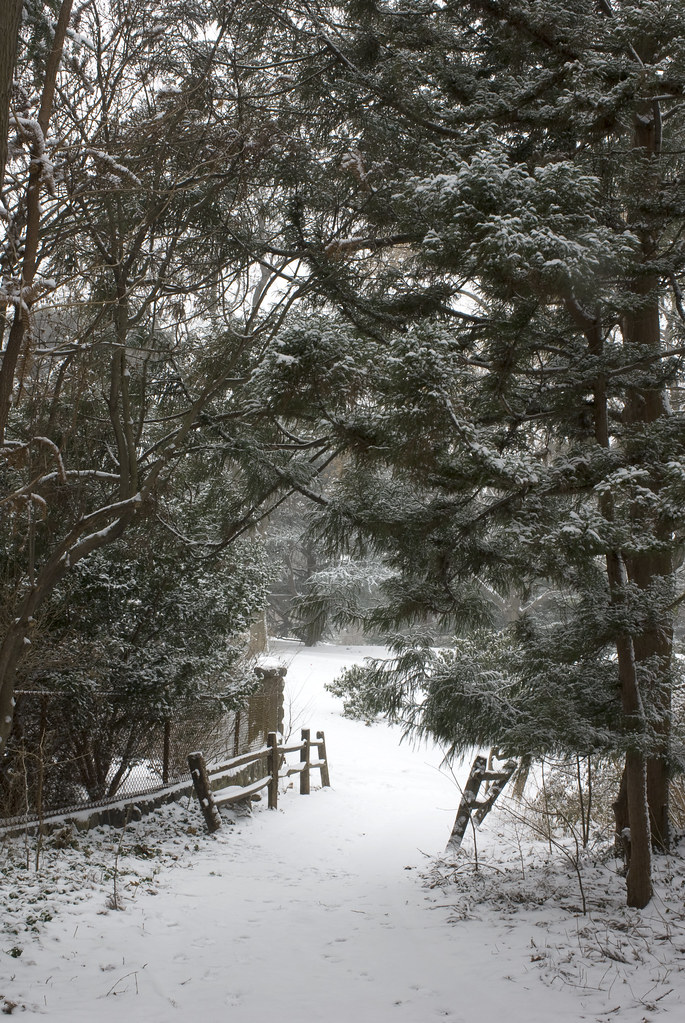 Recently, I took a Forest Tour with the very knowledgeable Garden Tour Guide Ken Lloyd. For those of you who don’t know what a Garden Tour Guide is, as I didn’t, they are expertly trained volunteers who are essential to the Garden’s success.
Recently, I took a Forest Tour with the very knowledgeable Garden Tour Guide Ken Lloyd. For those of you who don’t know what a Garden Tour Guide is, as I didn’t, they are expertly trained volunteers who are essential to the Garden’s success.
It was a nippy day to say the least, especially since I was unprepared for the tour and as such hadn’t dressed in layers as I normally would have had I known (I take pride in my preparedness being a Mainer born and raised). So off I went with Ken in my dress pants and sneakers, braving the chilly air and our runny noses to explore some of the trees in the Garden.
Our first stop was at the umbrella pines that, as Ken pointed out, were planted in the very early 1900s. Their red-colored bark and multi-stemmed trunks made them a unique stop on our adventure. Just past the Everett Children’s Adventure Garden, we stopped at the Chinese elms along the road. Ken explained how Dutch elm disease, an introduced fungus, had decimated the American elm population. He also stated that there are some elm species that can be treated for the disease and others that are resistant to it.
On entering the Forest, I felt I was in the most peaceful place in the city. The Forest is kept as natural as possible—there is no snow removal from the paths, no native trees are cut, and life is allowed to take its course. However, invasive species that encroach the area are removed and fires that start are put out. None of the descriptive signs I encountered elsewhere on the Garden grounds were present in the Forest, but Ken was able to discern the species from their bark or the form of the tree itself, by the way the branches grow and the shape of their buds. The only signs present were placed only on a few trees in order to track changes that occur over time. Volunteers record these changes once a month.
I also learned the reason why the trees aren’t any bigger or older in the Forest, despite the lack of human involvement. During the last Ice Age, a fair bit of the soil was removed by glaciers and deposited into the ocean. As a result of this shallow soil, it is difficult for the trees to establish a good root system that would allow them to reach monstrous heights.
I highly recommend taking one of The New York Botanical Garden’s many Tour Guide-led tours—it was definitely one of the highlights of my internship here. I learned a substantial amount despite my damp, cold feet. Just be sure to dress appropriately for the weather so you’re able to immerse yourself completely in the experience.
A guided Forest Tour will be held on Saturday, January 31, at 12:30 p.m. Meet at the Reflecting Pool in the Leon Levy Visitor Center.
Check out Saturday’s programming.
Check out Sunday’s programming.
Posted in Programs and Events, Wildlife on January 23 2009, by Plant Talk
Colors of Cardinals, Ducks, and More Dazzle Against the Snow
 |
Debbie Becker leads a free bird walk at the Garden every Saturday from 11 a.m. to 12:30 p.m., beginning at the Reflecting Pool in the Leon Levy Visitor Center. |
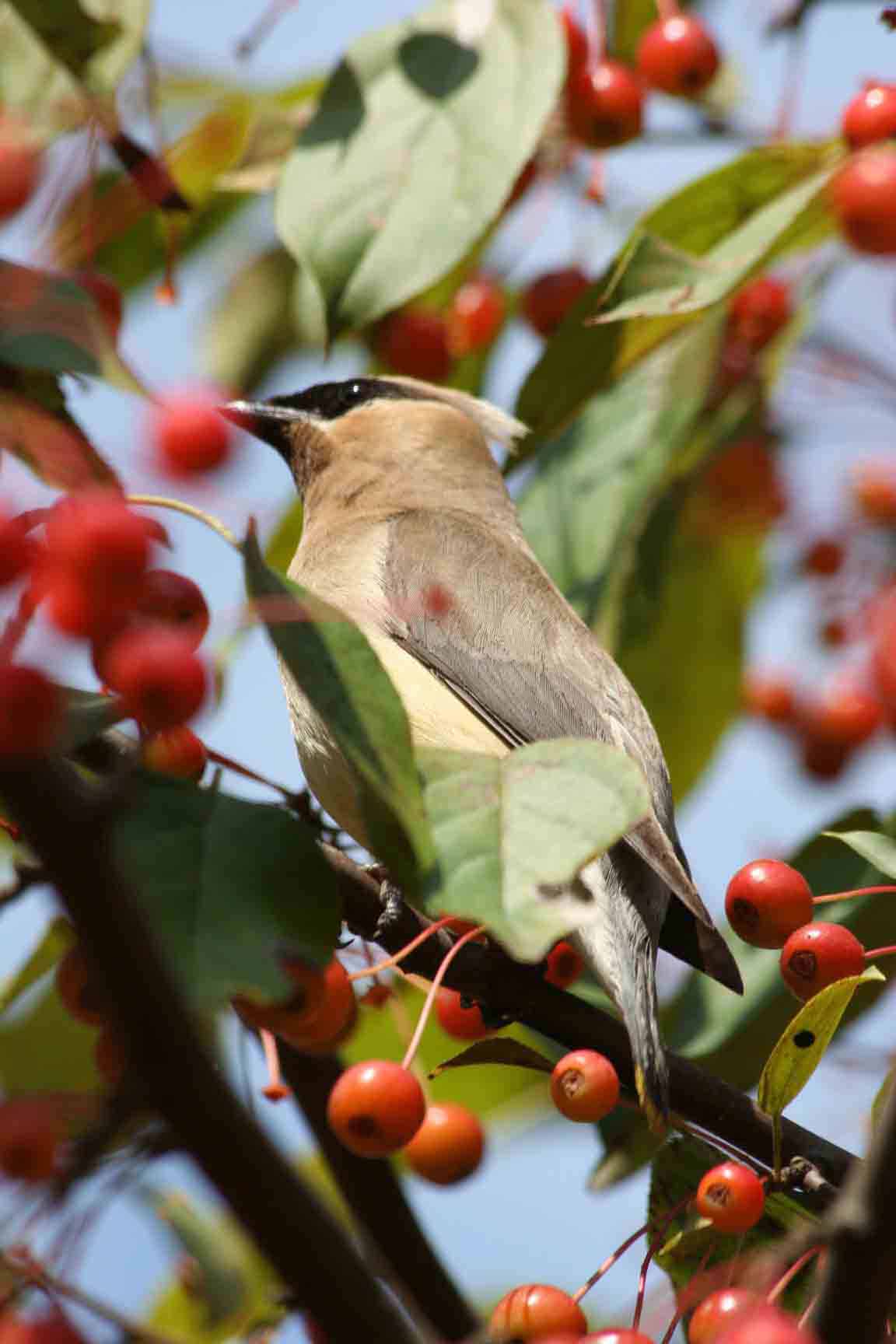 Winter birding at NYBG is always a delight. Once the deciduous trees have shed their leaves all is visible. Streaks of winter sun embrace the Forest and ignite the trees in deep silhouettes and wonderful brown hues. There is something about the frosty sunlight that brings out the vibrant color of the birds. The red-bellied woodpecker’s cap glows in red amber as the bird climbs a tree barking for attention. The northern cardinals are so brilliant in the sun as they sit on the bare branches—their red and orange feathers a sharp contrast to the white snow and brown tree stems. Even the blue jays’ cerulean feathers glow like a Matisse as the birds peck around the snow for morsels to eat.
Winter birding at NYBG is always a delight. Once the deciduous trees have shed their leaves all is visible. Streaks of winter sun embrace the Forest and ignite the trees in deep silhouettes and wonderful brown hues. There is something about the frosty sunlight that brings out the vibrant color of the birds. The red-bellied woodpecker’s cap glows in red amber as the bird climbs a tree barking for attention. The northern cardinals are so brilliant in the sun as they sit on the bare branches—their red and orange feathers a sharp contrast to the white snow and brown tree stems. Even the blue jays’ cerulean feathers glow like a Matisse as the birds peck around the snow for morsels to eat.
Perhaps the most spectacular sight in winter are the ducks on the Bronx River. White-and-crimson-orange hooded mergansers bob in the gentle flow of the river, their white heads parallel to the white snow on the river’s banks. The female with her spiked burgundy head is a sharp contrast and a delight to watch as she dives under the water searching for food.
Cedar waxwings dressed in yellow, red, and beige with a black mask pop yellow, red, and purple crabapples off the branches and into their beaks, making the perfect palette of color come alive.
Tiny black, gray, and white chickadees dance on the sweet gums’ brown sticky seed balls, pecking inside for the last of the autumn treat. Flocks of white-throated sparrows dance in the oak leaves on the ground, hopping back and forth in efforts to dislodge a hibernating spider from its berth. It is a well-choreographed movement that can be played in one’s mind to Beethoven’s Fifth.
One of the great joys of winter birding is hand-feeding chickadees. It is at this time of year that the chickadees, tufted titmice, and occasionally a cardinal are apt to land in one’s outstretched palm if you offer black oil sunflower seeds or roasted peanuts. The birds need the food for nourishment and to keep warm during the cold days of winter. Chickadee use a technique of shivering to keep their body temperatures high enough to survive and the protein from the sunflower and peanuts give them the fuel to perform the shivering technique.
Red-tailed hawks, Cooper’s hawks, and sharp-shinned hawks are also quite visible as they quietly sit on a branch waiting to pounce on their next victim.
In the quietness of the snow, in the shadows of the winter sun, the birds often reflect the silence of the season with a warm melody of song.
Check out Saturday’s programming
Check out Sunday’s programming
Posted in Learning Experiences, Programs and Events on January 22 2009, by Plant Talk
 |
Jeff Downing is Vice President for Education. |
In the past year the Garden has developed a number of training programs in conjunction with the New York City Parks Department to help increase the pool of capable job candidates. First, the Garden’s Horticulture and Education divisions collaborated on an urban tree care course to train a new generation of Parks foresters. Next, the Garden designed a special course for the Parks Opportunity Program, which trains local career-seekers in the fundamental skills necessary for the numerous vacant horticulture positions at the Parks Department and elsewhere. Recently, the Garden devised yet another program, one that is training 30 competitively selected 18–24-year-olds to help facilitate Mayor Bloomberg’s Million Trees Initiative.
The common thread in all of these wonderful initiatives is opportunity: Even in uncertain economic times the field of horticulture offers a wealth of career prospects for those willing to learn the required professional skills. And the opportunities are not just in New York City but throughout the region and beyond.
It has hit me that we at the Garden need to do a better job of spreading the word about the multitude of horticulture-related career tracks—from propagation and plant care to arboriculture, landscape and garden design, and horticultural therapy (using plants in therapeutic settings). So in the fall, the Garden’s Continuing Education program organized a couple of free Career Information Sessions and asked recent Continuing Ed certificate recipients to come and discuss their experience in the Garden’s education program and how it helped them get started in a new career.
Landscape Design graduate Robert Welsch talked about his burgeoning business, Westover Landscape Design, in Westchester. Sheri Forster explained how the Horticulture certificate she earned just this past spring allowed her to jumpstart a thriving business of her own, The Scottish Gardener, in Manhattan. Other former students and program instructors rounded out the evenings, giving their own unscripted and unedited appraisals of the business of horticulture and the Garden’s education programs. The give and take was free flowing, and those who came asked all the questions I would want to know if I were thinking about a new career such as:
If you missed these informative sessions but are interested in learning the answers to these questions (and any others) about careers in horticulture and landscape design, we’ve arranged to do the whole thing again, with a new group of students and instructors. So mark your calendar for Wednesday, January 28, from 6 to 8 p.m. and pre-register to attend our free Career Information Session.
I hope to see you there!